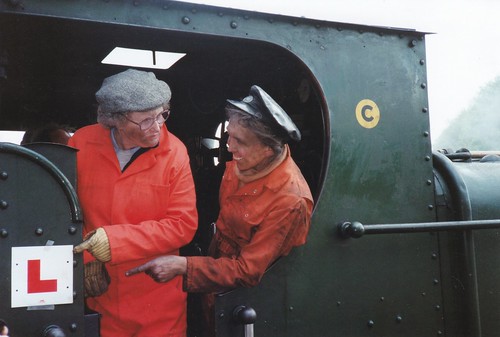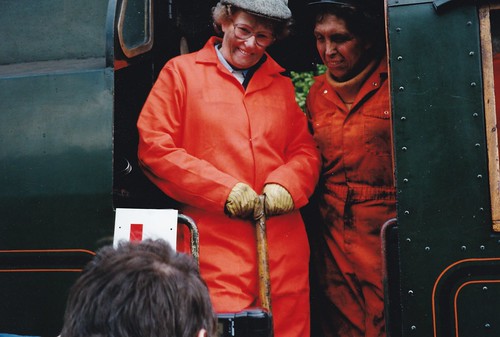'Flying Scotsman' made three visits to Birmingham Railway Museum offering modified 'Learn to be a Driver' courses in 1992, 1993 and 1994 and these are briefly described in the post here).
The line at Tyseley was only short, giving trainees the advantage of plenty of practice in starting, stopping and reversing a locomotive. However, to enable trainees to experience being 'on the road' , hauling a train of coaches, Birmingham Railway Museum made an agreement with the Shackerstone Railway Society to use their 5-mile line (marketed as The Battlefield Line) for Footplate Experience Courses when the line was not otherwise in use for service trains.
In the first 25 years of its existence, the railway at Shackerstone had operated using a variety of industrial steam locomotives so the Birmingham Railway Museum initiative represented something of a step change. The course format retained the 'safety briefing', 'little engine' and 'big engine' format of the Tyseley courses, but the other features were normally omitted. Birmingham Railway Museum marketed these courses, provided the motive power and suitably-qualified footplate crews for instructing on these courses. I was one of the instructors 'parachuted in' from Tyseley (along with John, George, Dave Davies. and Tony M.). I thought it only right to also become a member of the Shackerstone Railway Society as well, with the result that I'm still doing driving turns at 'The Battlefield Line', over a quarter of a century later.
In May 1993, Bullied 'Pacific' 34027 'Taw Valley' arrived at Shackerstone by low loader and, together with pannier tank 7752 the successful courses commenced. 7752 was often used for initial familiarisation of the trainees, running up and down within 'station limits' at Shackerstone. As at Tyseley, 'single manning' was allowed on this engine, with the instructor driver supervising the trainees and acting as fireman. 'Taw Valley' ran with four empty coaches to Shenton, ran round and returned to Shackerstone. Two instructor drivers were rostered for this, one supervising the trainee driver, the other supervising the trainee fireman (or, more often, just did the firing whilst the trainee enjoyed the ride prior to their turn to drive). A guard rode in the coaches.
On 'Taw Valley', I was often rostered with Dave Davies - a 'Southern' engineman to his fingertips, who'd fired Bullied 'Pacifics' out of London. With the withdrawal of steam, he moved onto diesel-electric freight locomotives, becoming an instructor for British Rail. The footplate experience courses through Birmingham Railway Museum re-kindled his interest in steam and he later gained quite a following for his exploits on main-line steam specials. I found him a very good-natured and generous 'mate' and, on these footplate courses, he would often let me look after the trainee driver to give him a chance to show his prowess with the shovel. Eventually, 'Taw Valley' left Shackerstone for work elsewhere.

BRM driving courses at Shackerstone: Bunty and Jan on 7752 (posed for newspaper photographer with 'L' plate) 15-May-1993.

BRM driving courses at Shackerstone: Bunty and Jan on 'Taw Valley' (posed for newspaper photographer with 'L' plate) 15-May-1993
As far as I remember, 7752 was then promoted to giving trainees the experience of running a train to Shenton whilst Shackerstone's then-resident 0-6-0 saddle tank 'Lamport No. 3' took over the role of 'little engine'. 'Lamport No. 3' (Bagnall works number 2670) was one of a batch of six locomotives built for Staveley Coal & Iron in 1942 and put to work in Lamport Quarries, Northamptonshire. I rather liked the engine. It steamed well, pulled well and the compensated springing gave quite a good ride. The setting of the regulator offered easy 'finger-tip' steam control. This is often associated with a tendency for the regulator to leak, but I never remember a problem.
By 1994, pannier 7752 had returned to Tyseley and was replaced by another Tyseley pannier, 7760, which was turned out in red London Underground livery with the running number 'L90'. Although historically correct (both 7752 and 7760 were both part of the London Underground fleet before moving into preservation), I never quite got used to its appearance.
Also in 1994, the locomotive shed at Shackerstone was extended to give more under-cover storage for 'big engines'.
There were a number of visiting locomotives to the Battlefield Line in the late 1990s. Although I got to drive all of them on service trains (except the B.R. 'Standard' 2-6-0 76079), I'm unsure how many were involved in footplate experience courses.
I think there were two visiting engines in 1996 - the 'N2' 0-6-2 tank engine 69523 and the double-chimney 'Jubilee' 45595 'Bahamas'. Around this time, a footplate course full-colour publicity brochure featuring 'Bahamas' was issued.

Part of the pamphlet advertising driving courses at the Battlefield Line (Chris Simmons collection)
Unfortunately, the rather nice shot of 'Bahamas' entering Shackerstone was printed 'mirror-image'. Here it is the right way round:-

'Bahamas' fireman surrendering the single line staff to the signalman at Shackerstone (from the BRM pamphlet but, this time, the right way round!)
In 1997, the preserved Coal Tank, 'Jubilees' 45593 'Kolhapur' and (again) 45596 'Bahamas' were on site. In addition, pannier tank 7762 returned and 0-6-0ST 'Victor' (Bagnall works number 2996, built in 1951 for Steel Company of Wales) was moved by the private owner, Warwick Ormandy, from Tyseley to become resident at Shackerstone.
In 1998, B.R. 'Standard' 2-6-0 76079 was on site (the one visitor I didn't get to drive) together with L&Y surviving 0-6-0 freight tender locomotive 1300 (which, prior to preservation, had been 52322). I really must try to document some of my experiences in this interesting period. In 1998, Birmingham Railway Museum's ambition was to operate regular steam on the main line between Birmingham and Stratford, under the 'Vintage Trains' brand. To accommodate this, the Birmingham Railway Museum Footplate Courses at both Tyseley and Shackerstone were discontinued. Regular 'Shakespeare Express' services started in 1999.
This didn't mark the end of my involvement with instructing on footplate courses. At first, for a while, I was involved with courses on the West Somerset Railway and then, as a volunteer at Peak Rail, I regularly instructed trainees there, until 2019. I'll try to expand my posts describing footplate courses.
After Birmingham Railway Museum discontinued the courses at Shackerstone, the Battlefield Line decided to market a modified format themselves, so I've continued to be involved as required until the Coronavirus pandemic in 2020 prevented footplate courses from being held. The limited operations which have been possible in 2020 are outlined in the post Operations at the Battlefield Line in 2020.
Pictures
BRM driving courses at Shackerstone.
